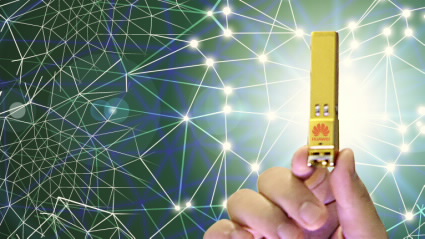MWC2014: MIMO 2x2: 2 in phones, routers in SFP modules ...
Among the many announcements MWC2014 I want to highlight two. One, louder, from Broadcom, he himself still makes a lot of noise. The second, quieter, from Huawei - everything is “without noise and dust”, but very interesting.
Broadcom announced a WLAN-chipset for mobile devices with support for 802.11ac 2x2: 2 MIMO (867Mbps), causing a considerable stir in the press. Let's figure it out.
So, 867Mbps, speak?
What then from it sense, speak?
Well, for starters, if you transmit something in half the time, it will take half as long. Since airtime is the key resource of a Wi-Fi network, total cell capacity will increase (the number of clients or the average speed per client with the same amount). At the same time, because The antennas are less time consuming in transmission, you can save some energy. But this is all only with a small amount of transfers (browsing), which will go directly to the RAM of the phone (if the manufacturer has implemented such a feature). And even then, you still need, after all, to give data at such a speed - and that means buffering at the point, and decent, otherwise there will be no difference from the “usual” 802.11ac@433Mbps.
')
But what can really help is MRC and STBC technologies, in combination with the 2x2: 1 mode or, in general, 1x2: 1.
Total, as well as with 802.11ac itself, the main improvement here is not the speed (which marketers will sell us), but the range and clarity of the signal. Again, purely for battery reasons, it is interesting for me to compare this 2x2: 2 and 1x2x1 (it takes less energy to receive) and see if the game is worth the candle. Time will tell - it looks like such a chipset is in the Galaxy S5.
But what was really missed by most MWC reviewers under the noise of announcements of smartphones, is this thing :

This is a full-fledged SFP format router. With support for IPv6 and even SDN. The level of all these supports, of course, should be checked - but the idea itself! Can you imagine what can potentially be done with such a thing, especially by adding a WWAN modem to it?
Broadcom announced a WLAN-chipset for mobile devices with support for 802.11ac 2x2: 2 MIMO (867Mbps), causing a considerable stir in the press. Let's figure it out.
So, 867Mbps, speak?
- Does someone have gigabit internet at home?
- Someone saw how fast hotspot?
- Who has a NAS at home for movies with really fast RAID? Even a single SSD can not always give data so quickly. [UPD] Here I got a little hot, confusing Mb and MB. [/ UPD]
- Who has the confidence that the phone will be able to write it so quickly on the built-in flash memory (not to mention the card)? The data I have show speeds of about 35-65Mbps for the average phone.
- Two antennas = at least twice the power consumption. How will this affect battery life?
What then from it sense, speak?
Well, for starters, if you transmit something in half the time, it will take half as long. Since airtime is the key resource of a Wi-Fi network, total cell capacity will increase (the number of clients or the average speed per client with the same amount). At the same time, because The antennas are less time consuming in transmission, you can save some energy. But this is all only with a small amount of transfers (browsing), which will go directly to the RAM of the phone (if the manufacturer has implemented such a feature). And even then, you still need, after all, to give data at such a speed - and that means buffering at the point, and decent, otherwise there will be no difference from the “usual” 802.11ac@433Mbps.
')
But what can really help is MRC and STBC technologies, in combination with the 2x2: 1 mode or, in general, 1x2: 1.
- With two receiving antennas, the MRC allows to recombine the original data stream from copies of the received signal by mathematics, improving the receiver sensitivity (“medium temperature-in-hospital” by 3 dB) and significantly increasing the noise immunity in general (the number of errors and, accordingly, packet retransmissions are reduced).
- With two transmit antennas, STBC allows, through mathematics, to transmit one data stream so that the MRC receives the signal in the best shape, adding a “mathematical” gain to the transmission.
- As a result, we obtain a significant improvement in the Rate-over-Range parameter due to a better signal-to-noise ratio and a decrease in the number of errors. That, you see, is important for a small-sized device, most of whose antennas are covered by the user's palm.
Total, as well as with 802.11ac itself, the main improvement here is not the speed (which marketers will sell us), but the range and clarity of the signal. Again, purely for battery reasons, it is interesting for me to compare this 2x2: 2 and 1x2x1 (it takes less energy to receive) and see if the game is worth the candle. Time will tell - it looks like such a chipset is in the Galaxy S5.
But what was really missed by most MWC reviewers under the noise of announcements of smartphones, is this thing :

This is a full-fledged SFP format router. With support for IPv6 and even SDN. The level of all these supports, of course, should be checked - but the idea itself! Can you imagine what can potentially be done with such a thing, especially by adding a WWAN modem to it?
Source: https://habr.com/ru/post/215421/
All Articles